Track Modulus Assessment of Engineered Interspersed Concrete Sleepers in Ballasted Track
Abstract
:1. Introduction
2. Background and Theory
3. Field Experimentation Methods
3.1. Engineered Interspersed Concrete (EIC) Sleeper
3.2. Field Site and Instrumentation
3.3. Single-Point Load Method for Track Modulus Calculation
4. Results and Discussion
Wheel Load and Displacement Comparison Results
5. Conclusions
- The theoretical analysis showed that interspersed standard concrete sleepers placed within a timber-sleeper track can experience a load up to five times greater than the load supported by the adjacent timber sleepers.
- Based on measurements of sleeper displacement, both timber sleepers and EIC sleepers presented a similar track response. For timber sleepers, the median displacement value was 2.26 mm (0.089 in.), and for EIC sleepers, it was 2.21 mm (0.087 in.).
- The track-displacement results from the field instrumentation ranged from 1.22 mm (0.048 in.) to 4.32 mm (0.170 in.) for all timber sleepers.
- The track-modulus results indicated a median modulus of 12.95 N/mm/mm (1878 lbs./in./in.) for the timber sleepers, and 12.79 N/mm/mm (1855 lbs./in./in.) for the EIC sleepers.
- The variance in performance for the two sleeper types cannot be clearly distinguished with track-displacement or modulus results, which provides a favorable indication for future field performance.
Author Contributions
Funding
Institutional Review Board Statement
Informed Consent Statement
Data Availability Statement
Conflicts of Interest
References
- Matias, S.R.; Ferreira, P.A. Railway slab track systems: Review and research potentials. Struct. Infrastruct. Eng. 2020, 16, 1635–1653. [Google Scholar] [CrossRef]
- Railway Tie Association (RTA). Available online: https://www.rta.org/faq (accessed on 12 November 2020).
- Qiao, P.; Davalos, J.F.; Zipfel, M.G. Modeling and optimal design of composite-reinforced wood railroad crosstie. Compos. Struct. 1998, 41, 87–96. [Google Scholar] [CrossRef]
- McCombe, E.; Ryan, M. Development of sleeper strategies focusing on timber sleeper replacement. In Proceedings of the AusRAIL PLUS 2003, Investing in Australian Rail-Strategies and Solutions, Sydney, Australia, 17–19 November 2003. [Google Scholar]
- Alexander, H.L. Railroad Decision Support Tools for Track Maintenance. Ph.D. Thesis, University of Illinois at Urbana-Champaign, Champaign, IL, USA, 2017. [Google Scholar]
- Bastos, J.C.; Dersch, M.S.; Edwards, J.R. Statistical Prediction of Center Negative Bending Capacity of Pretensioned Concrete Crossties. J. Transp. Eng. Part A Syst. 2020, 146, 04019074. [Google Scholar] [CrossRef]
- Alvaro, E.C.R.; Qian, Y.; Edwards, J.R.; Dersch, M.S. Analysis of the Temperature Effect on Concrete Crosstie Flexural Behavior. Constr. Build. Mater. 2019, 196, 362–374. [Google Scholar]
- Bastos, J.C.; Alejandro, Á.R.; Dersch, M.S.; Edwards, J.R.; Barkan, C.P.L. Laboratory Characterization of Structural Capacity of North American Heavy Haul Concrete Crossties. Transp. Res. Rec. J. Transp. Res. Board 2018, 2672, 116–124. [Google Scholar] [CrossRef]
- Edwards, J.R.; Canga, R.A.E.; Cook, A.A.; Dersch, M.S.; Qian, Y. Quantifying bending moments in rail-transit concrete sleepers. J. Transp. Eng. Part A Syst. 2018, 144, 04018003. [Google Scholar] [CrossRef] [Green Version]
- Naaman, A.E. Prestressed Concrete Analysis and Design: Fundamentals, 2nd ed.; Techno Press: Ann Arbor, MI, USA, 2004. [Google Scholar]
- Ngamkhanong, C.; Chuah, M.W.; Sakdirat, K. Buckling Analysis of Interspersed Railway Tracks. Appl. Sci. 2020, 10, 3091. [Google Scholar] [CrossRef]
- Celestin, N. Influence of Spatial Variations of Railroad Track Stiffness and Material Inclusions of Fatigue Life. Ph.D. Thesis, University of Nebraska, Lincoln, NE, USA, 2015. [Google Scholar]
- Cai, Z.; Raymond, G.P.; Bathurst, R.J. Estimate of static track modulus using elastic foundation models. J. Transp. Res. Board 1994, 1470, 65–72. [Google Scholar]
- Arnold, R.; Lu, S.; Hogan, C.; Farritor, S.; Fateh, M.; El-Sibaie, M. Measurement of vertical track modulus from a moving railcar. In Proceedings of the American Railway Engineering and Maintenance-of-Way Association Annual Conference, Louisville, KY, USA, 17–20 September 2006. [Google Scholar]
- Fröhling, R.D. Deterioration of Railway Track Due to Dynamic Vehicle Loading and Spatially Varying Track Stiff-Ness. Ph.D. Thesis, University of Pretoria, Pretoria, South Africa, 1997. [Google Scholar]
- Fortunato, E.; Paixão, A.; Calçada, R. Railway Track Transition Zones: Design, Construction, Monitoring and Numerical Modelling. Int. J. Railw. Technol. 2013, 2, 33–58. [Google Scholar] [CrossRef]
- Buddhima, I.; Muhammad, B.S.; Trung, N.; Antonio, G.C.; Richard, K. Improved performance of ballasted tracks at transition zones: A review of experimental and modelling approaches. Transp. Geotech. 2019, 21, 100260. [Google Scholar]
- Wang, H. Measurement, Assessment, Analysis and Improvement of Transition Zones in Railway Track. Ph.D. Thesis, Delft University of Technology, Delft, The Netherlands, 2019. [Google Scholar]
- Korea Rail Network Authority (KR). KR C-14080: Interaction Between Track, Vehicle, Signal, Structure, Electricity; KR: Daejeon, Korea, 2012. [Google Scholar]
- Plotkin, D.; Davis, D. Bridge Approaches and Track Stiffness; Federal Railroad Administration: Washington, DC, USA, 2008.
- López Pita, A.; Teixeira, P.F.; Casas-Esplugas, C.; Ubalde, L. Deterioration in geometric track quality on high speed lines: The experience of the Madrid-Seville high speed line (1992–2002). In Proceedings of the TRB 85th Annual Meeting, Washington, DC, USA, 22–26 January 2006. [Google Scholar]
- Sanudo, R.; Dell’Oli, L.; Casado, J.A.; Carrascal, I.A.; Diego, S. Track transitions in railways: A review. Constr. Build. Mater. 2016, 112, 140–157. [Google Scholar] [CrossRef]
- Priest, J.A.; Powrie, W. Determination of Dynamic Track Modulus from Measurement of Track Velocity during Train Passage. J. Geotech. Geoenviron. Eng. 2009, 135, 1732–1740. [Google Scholar] [CrossRef]
- American Railway Engineering and Maintenance-of-Way Association (AREMA). Manual for Railway Enginnering; AREMA: Lanham, MD, USA, 2017.
- Lee, K.Y. A Study Improvement the Transition Area of Bridge and Embankment Using Reinforced Rail and Ballast Stabilizer. Master’s Thesis, Seoul National University of Science and Technology, Seoul, Korea, 2014. [Google Scholar]
- Radeş, M. Dynamic analysis of an inertial foundation model. Int. J. Solids Struct. 1972, 8, 1353–1372. [Google Scholar] [CrossRef]
- Avramidis, I.E.; Morfidis, K. Bending of beams on three-parameter elastic foundation. Int. J. Solids Struct. 2006, 43, 357–375. [Google Scholar] [CrossRef] [Green Version]
- Kerr, A.D. A study of a new foundation model. Acta Mech. 1962, 1, 135–147. [Google Scholar] [CrossRef] [Green Version]
- Kerr, A.D. The determination of the track modulus k for the standard track analysis. In Proceedings of the American Railway Engineering and Maintenance-of-Way Association Annual Conference, Washington, DC, USA, 24 September 2002. [Google Scholar]
- Tzanakakis, K. The Railway Track and Its Long Term Behaviour: A Handbook for a Railway Track of High Quality; Springer: Berlin/Heidelberg, Germany, 2013. [Google Scholar]
- Winkler, E. Die Lehre von der Elasticitaet und Festigkeit mit Besondere Ruecksicht auf ihre Anwendung in der Technik, fuer Polytechnische Schuhlen, Bauakademien, Ingenieure, Maschienenbauer, Architecten, etc.; H. Dominicus: Prague, Czech Republic, 1867. [Google Scholar]
- Rapp, C.T.; Dersch, M.S.; Edwards, J.R.; Barkan, C.P.L.; Wilson, B.; Mediavilla, J. Measuring Concrete Crosstie Rail Seat Pressure Distribution with Matrix Based Tactile Surface Sensors. In Proceedings of the American Railway Engineering and Maintenance-of-Way Association Annual Conference, Chicago, IL, USA, 16–19 November 2012. [Google Scholar]
- Edwards, J.R.; Aaron, C.; Dersch, M.S.; Qian, Y. Quantification of rail transit wheel loads and development of improved dynamic and impact loading factors for design. J. Rail Rapid Transit 2018, 232, 2406–2417. [Google Scholar] [CrossRef]
- Selig, E.T.; Waters, J.M. Track Geotechnology and Substructure Management; Thomas Telford Services: London, UK, 1994. [Google Scholar]
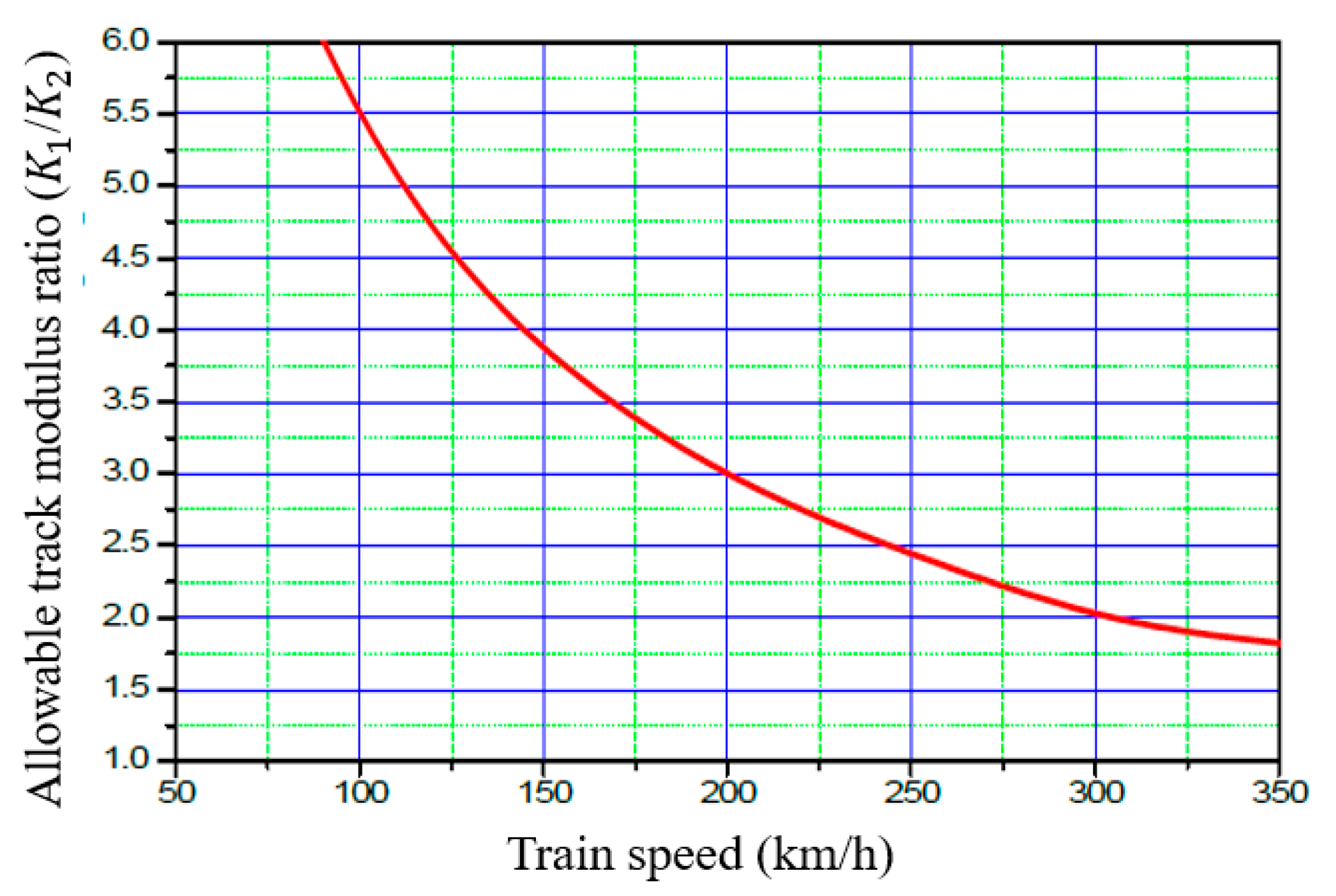
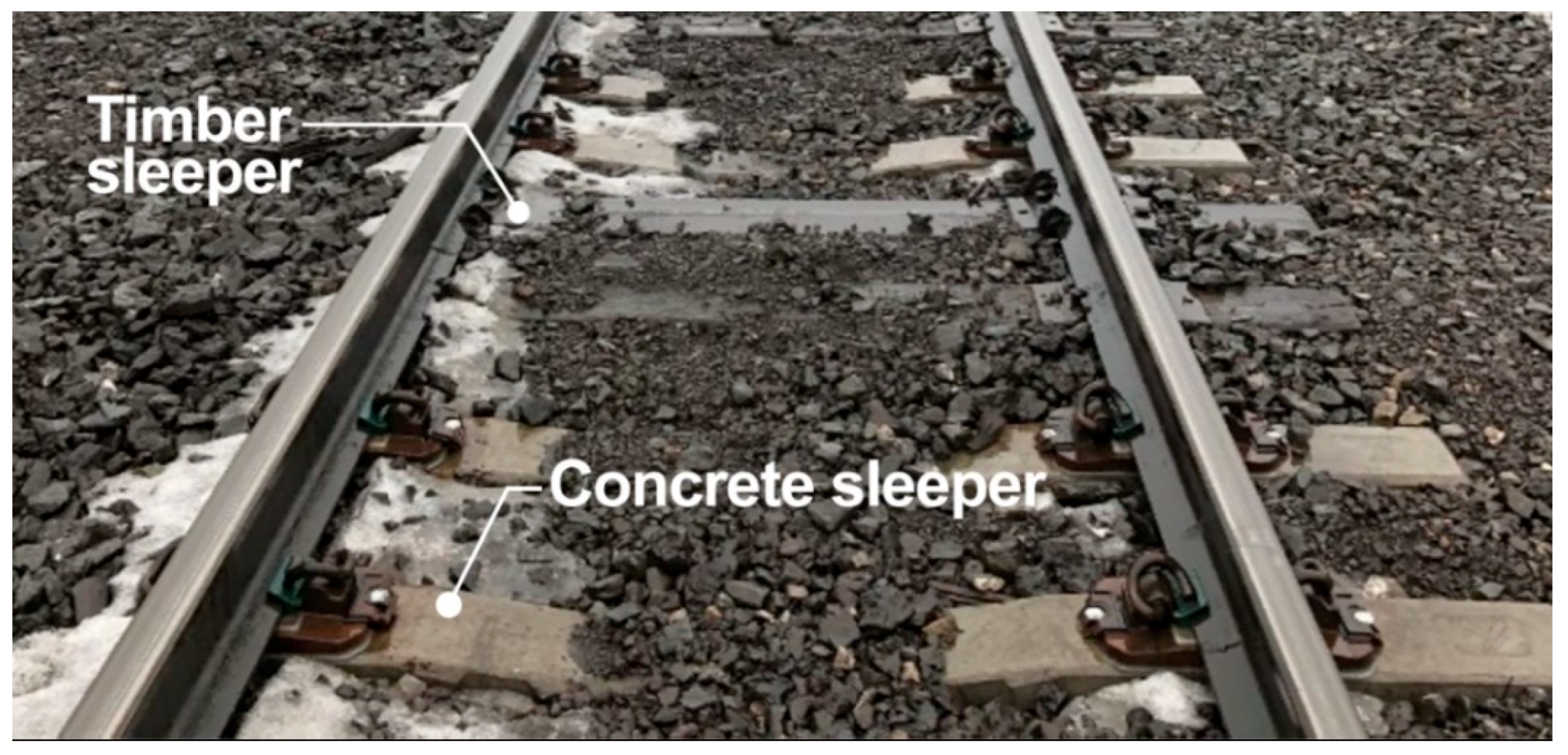
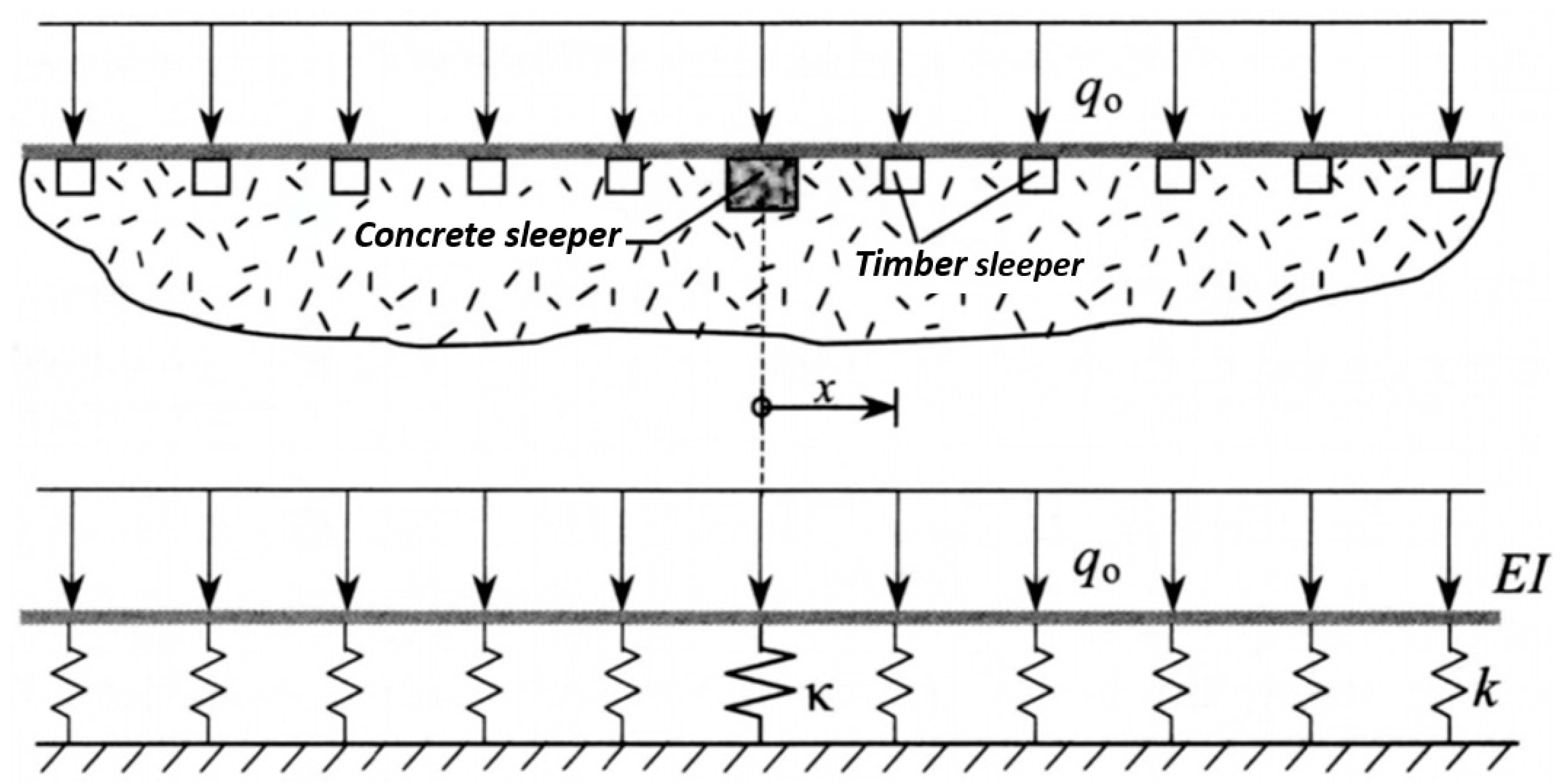
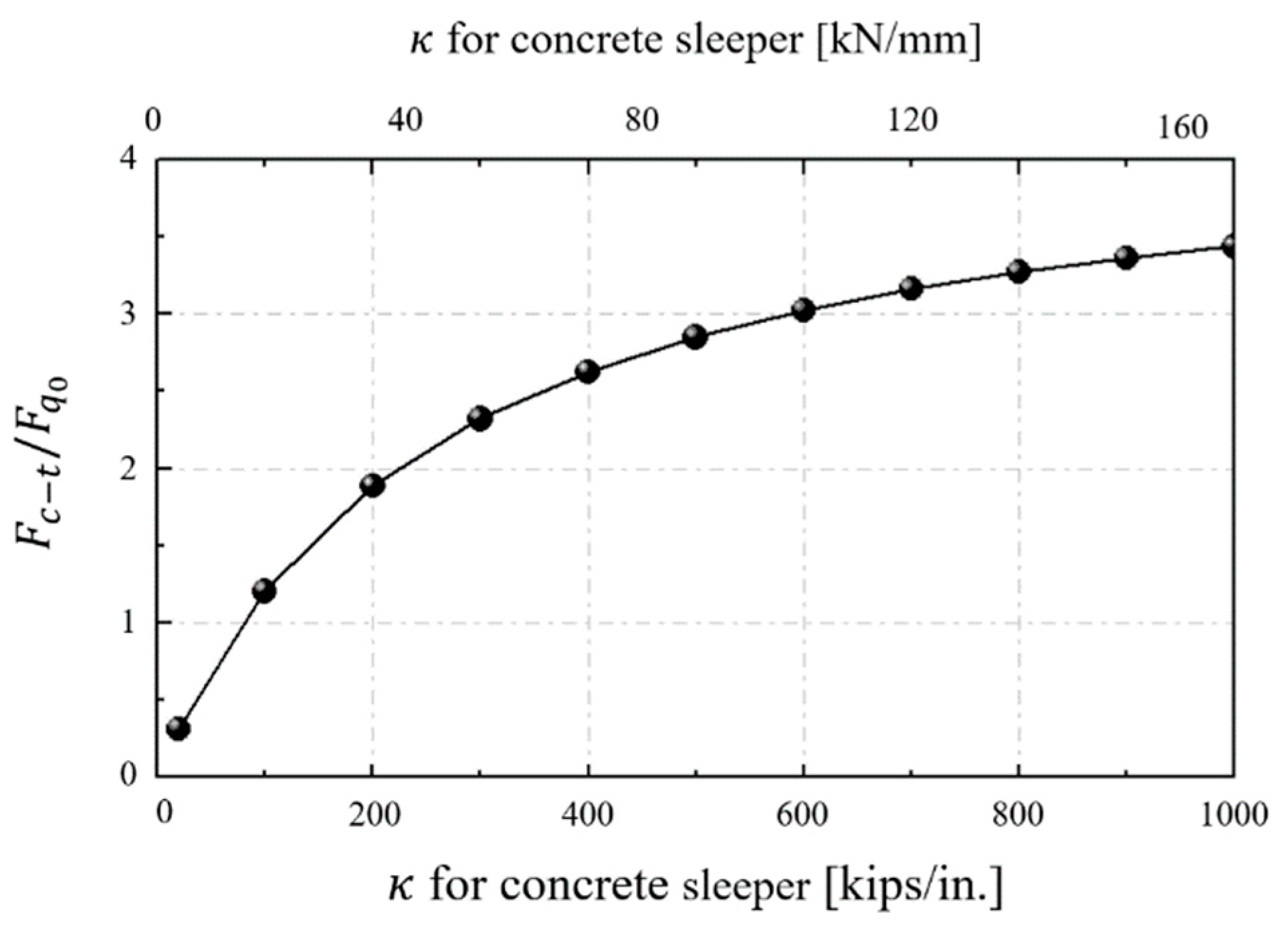
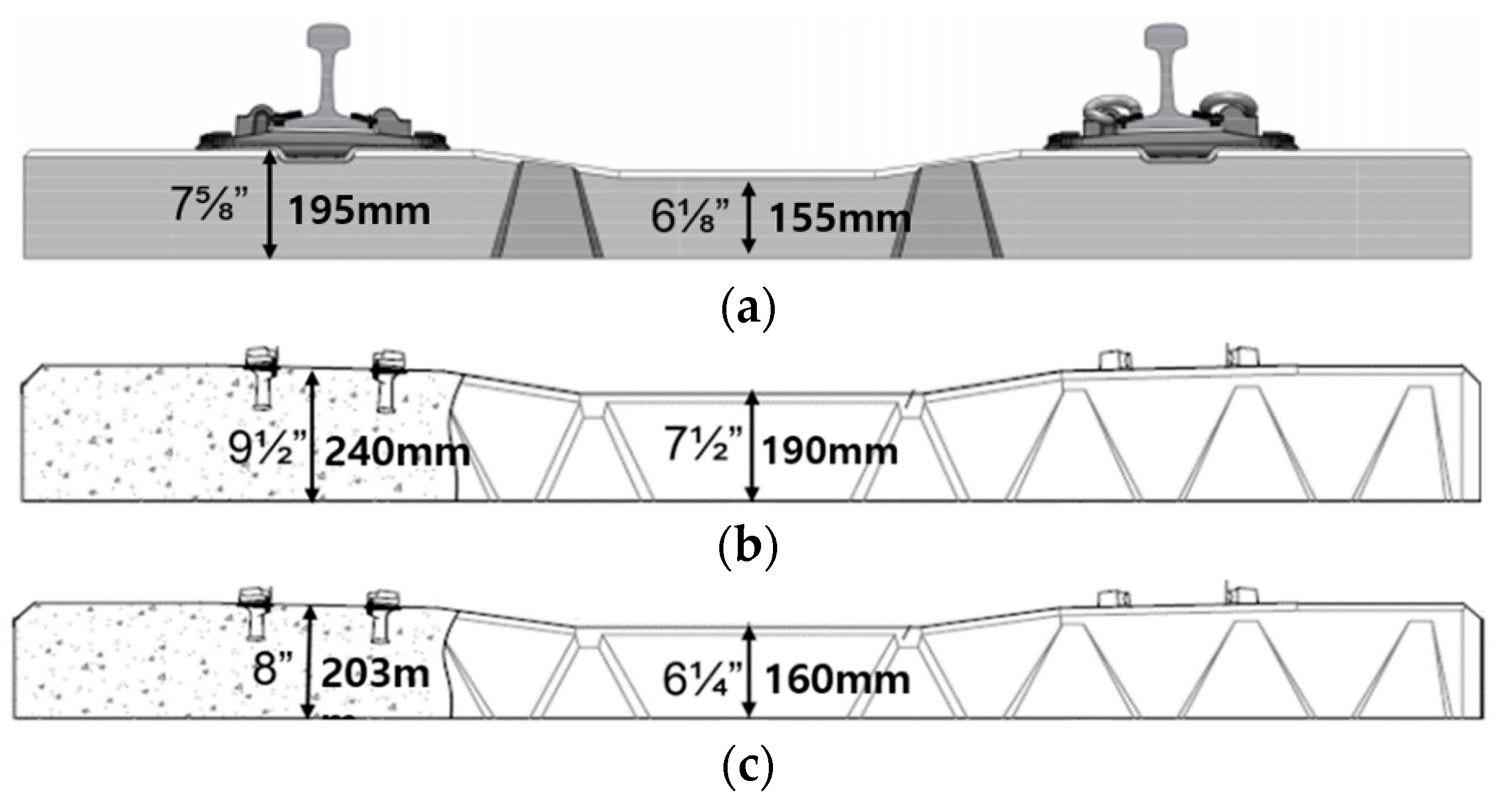

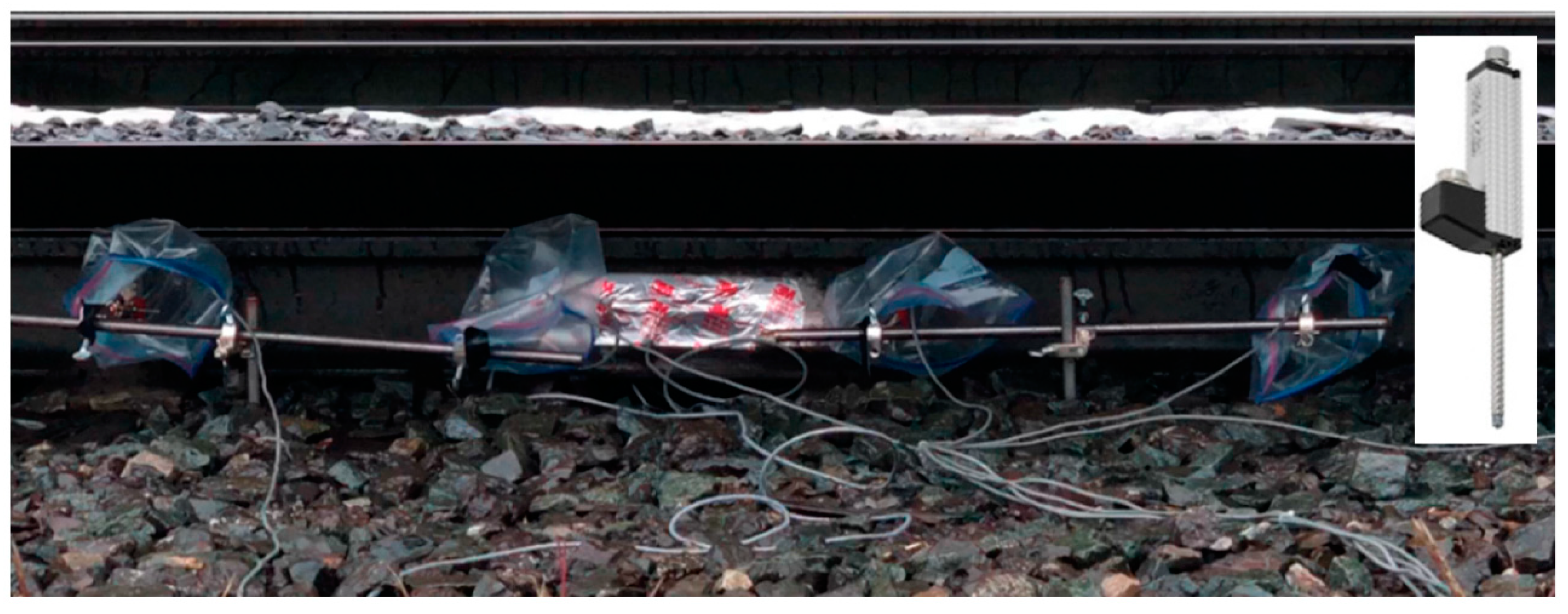
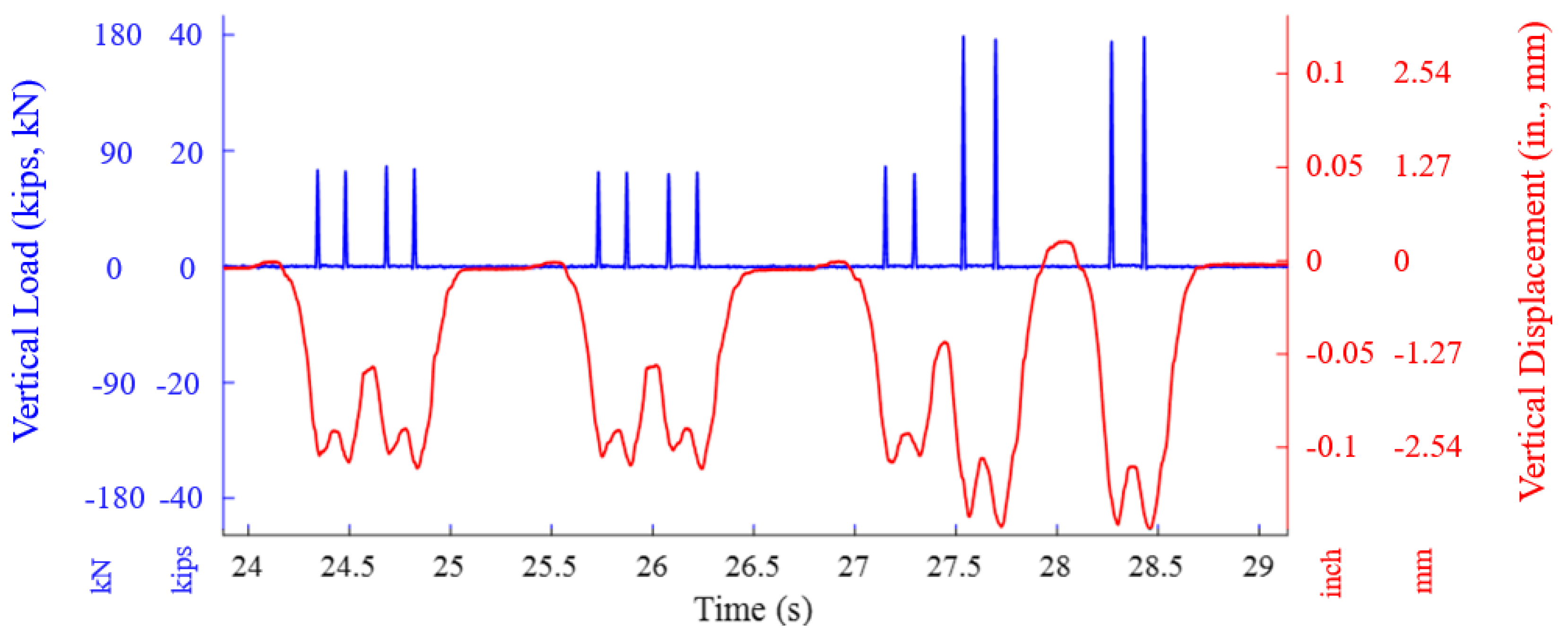
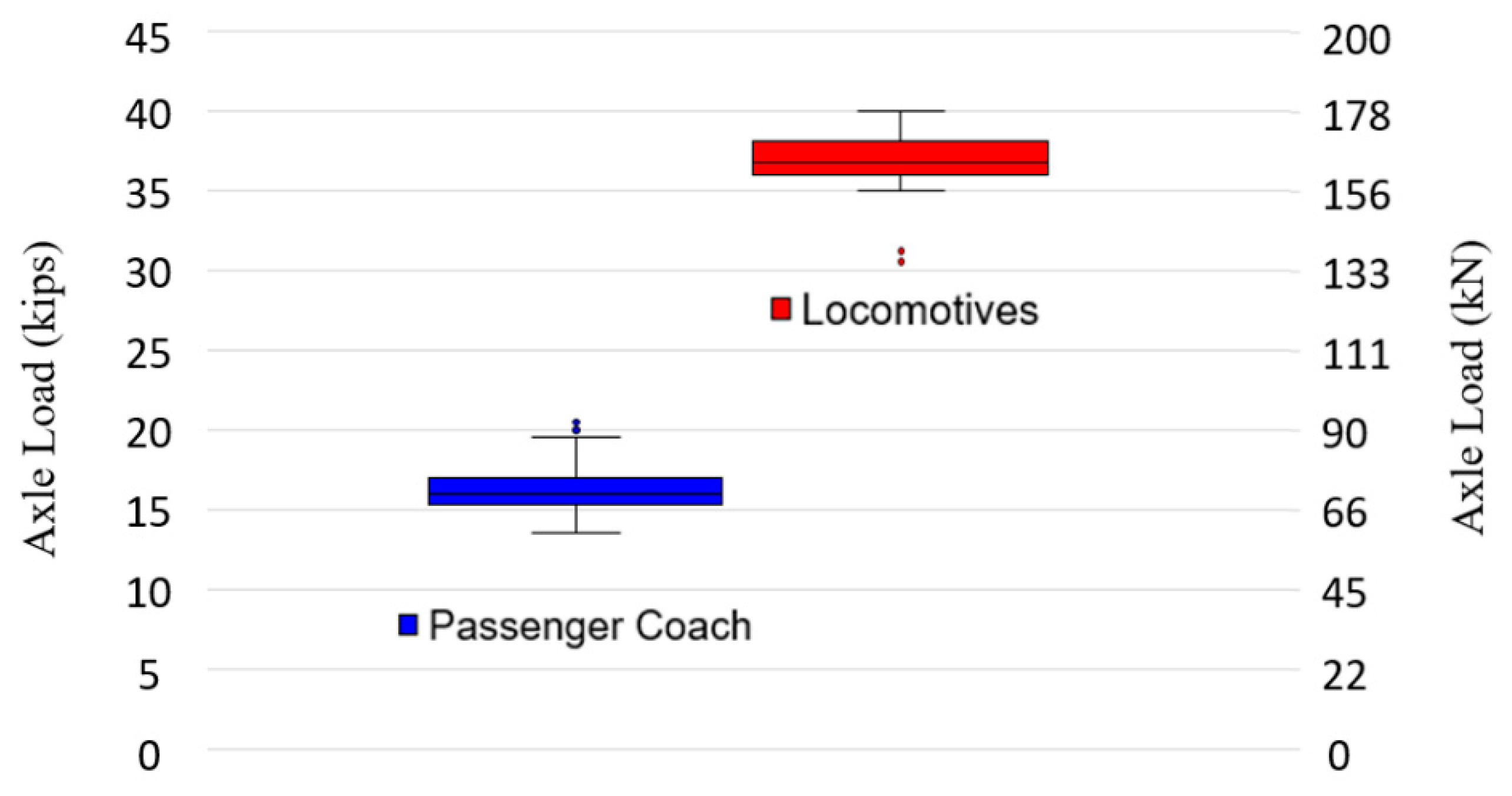
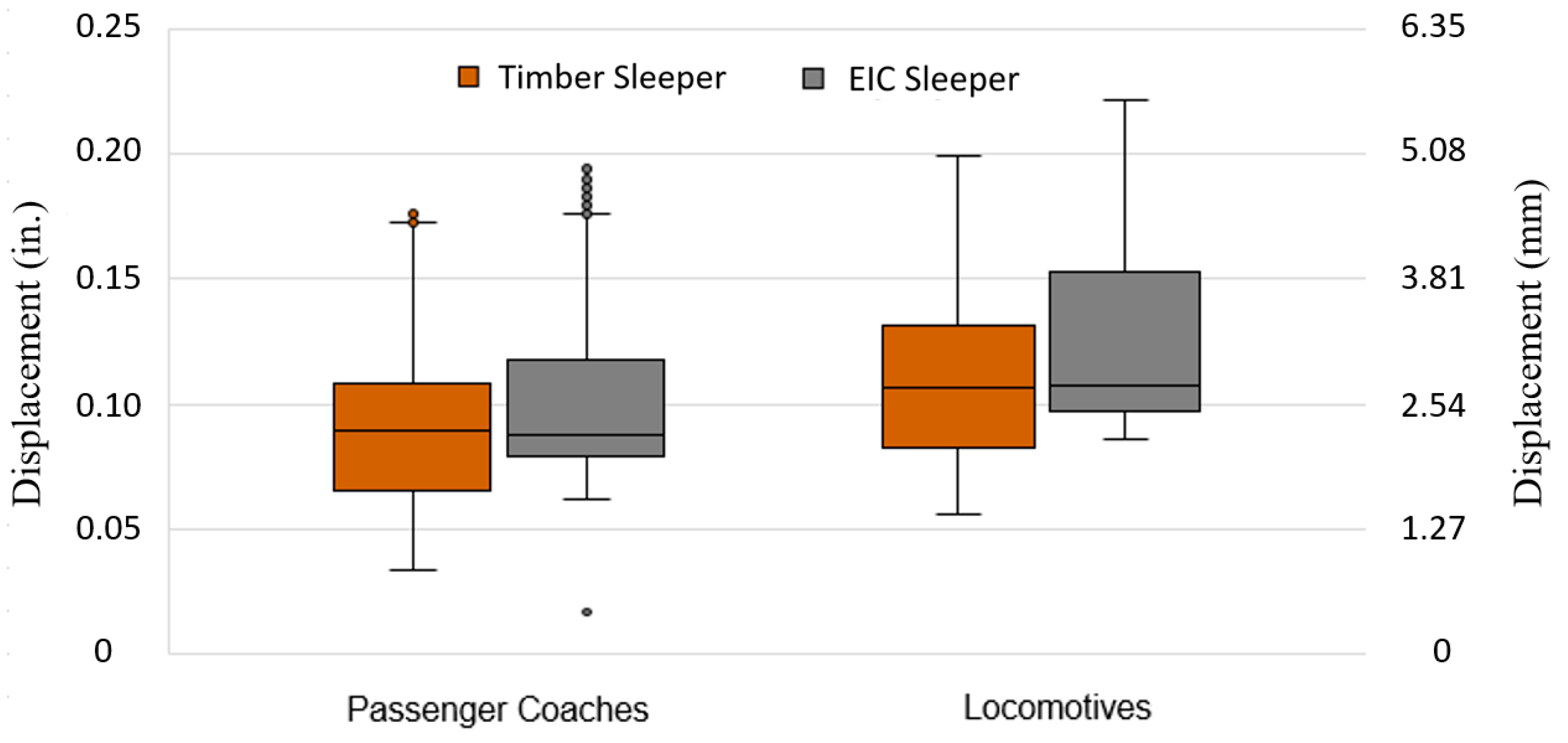
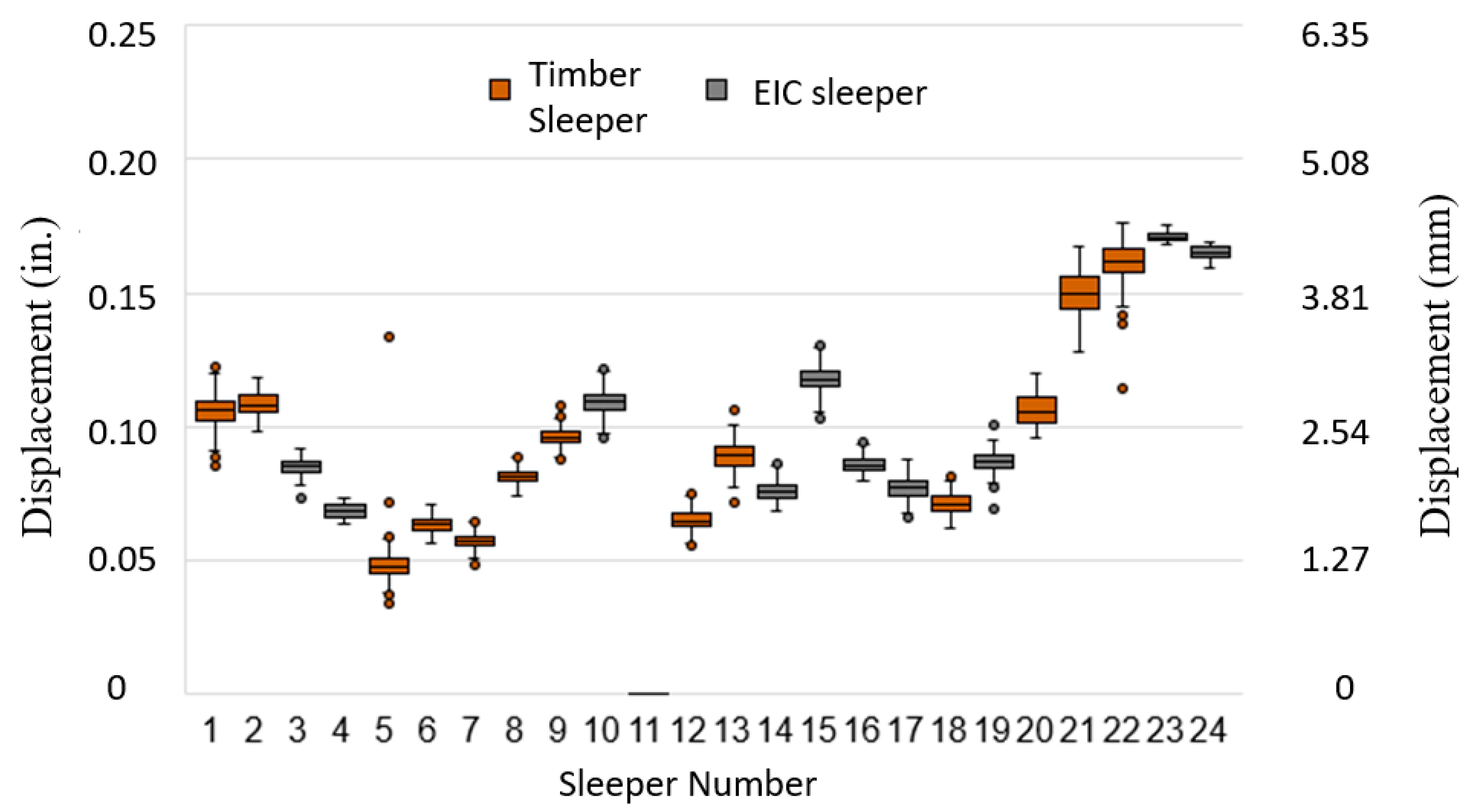
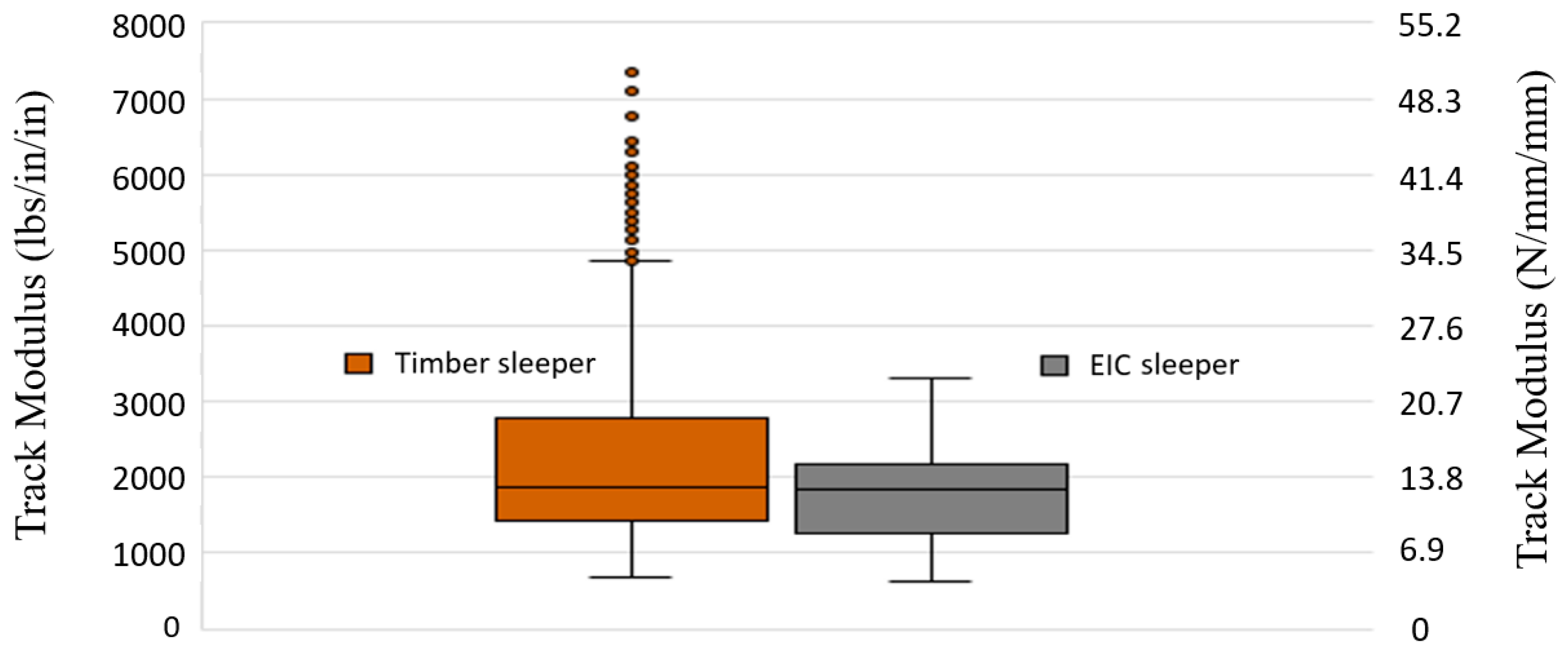
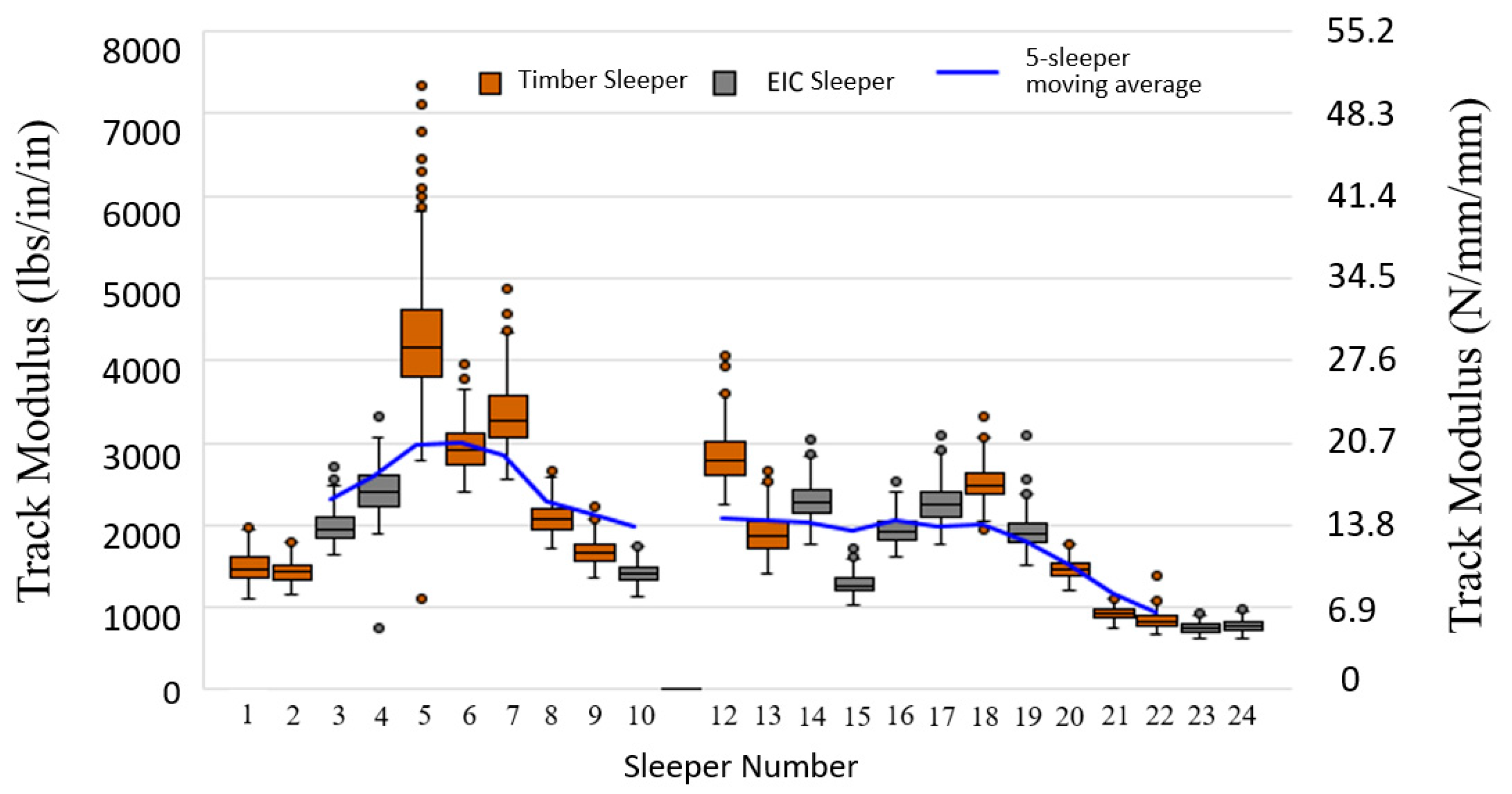
| Rail | Modulus of Elasticity | Moment of Inertia | Wood Timber Modulus, k | Sleeper Spacing | |
|---|---|---|---|---|---|
| 132RE | 210,000 MPa | 36,700,000 | 20.69 N/mm/mm | 508 mm | Variable |
| 30,000,000 psi | 88.2 | 3000 | 20 in. |
| 1.75 kN/mm 10 kips/in. | 17.51 kN/mm 100 kips/in. | 43.78 kN/mm 250 kips/in. | 87.56 kN/mm 500 kips/in. | 175.13 kN/mm 1000 kips/in. | |
|---|---|---|---|---|---|
| 0.160 | 1.204 | 2.124 | 2.851 | 3.440 |
Publisher’s Note: MDPI stays neutral with regard to jurisdictional claims in published maps and institutional affiliations. |
© 2020 by the authors. Licensee MDPI, Basel, Switzerland. This article is an open access article distributed under the terms and conditions of the Creative Commons Attribution (CC BY) license (http://creativecommons.org/licenses/by/4.0/).
Share and Cite
Lima, A.d.O.; Dersch, M.S.; Lee, J.; Edwards, J.R. Track Modulus Assessment of Engineered Interspersed Concrete Sleepers in Ballasted Track. Appl. Sci. 2021, 11, 261. https://doi.org/10.3390/app11010261
Lima AdO, Dersch MS, Lee J, Edwards JR. Track Modulus Assessment of Engineered Interspersed Concrete Sleepers in Ballasted Track. Applied Sciences. 2021; 11(1):261. https://doi.org/10.3390/app11010261
Chicago/Turabian StyleLima, Arthur de Oliveira, Marcus S. Dersch, Jaeik Lee, and J. Riley Edwards. 2021. "Track Modulus Assessment of Engineered Interspersed Concrete Sleepers in Ballasted Track" Applied Sciences 11, no. 1: 261. https://doi.org/10.3390/app11010261





